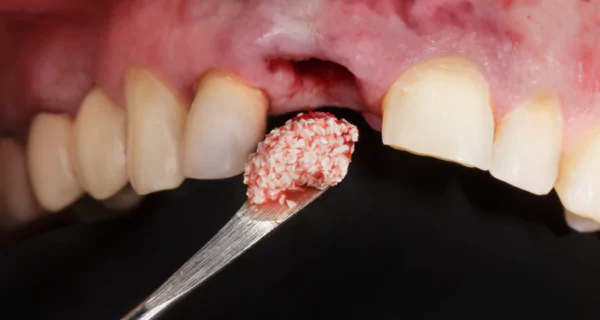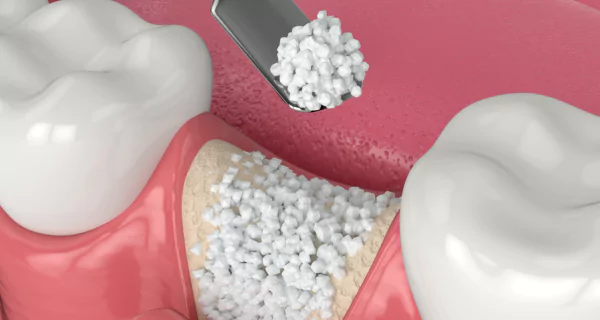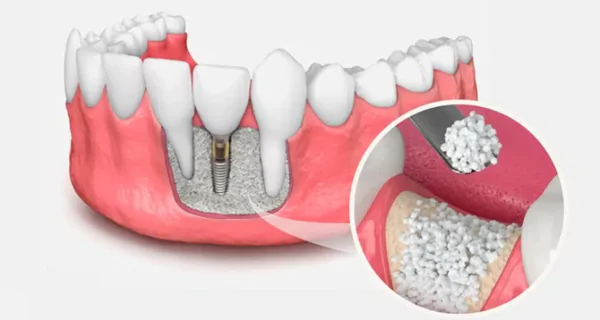Last Updated on: 16th December 2025, 11:03 am
Dental bone grafting is a transformative procedure in modern dentistry, designed to restore the health and structure of the jawbone. Often recommended as a preparatory step for treatments like dental implants or dentures, the procedure plays a vital role in addressing bone loss that can impact oral health and functionality. If you’ve been advised to undergo a bone graft in mouth, it’s natural to have questions: What does it involve? Why is it necessary? What should you expect during the healing process?.
In this article, we’ll explore the answers to these questions and provide a complete guide to help you understand dental bone grafting and its benefits. Whether you’re preparing for the procedure or simply looking to learn more, this resource aims to offer valuable insights and practical information.
What is a bone graft in dentistry?
A bone graft in the mouth is a type of surgery that helps repair and strengthen the jawbone. It involves placing new bone material, either from a natural source or made in a lab, into areas where the bone is missing, weak, or thin. The procedure helps rebuild the jawbone, making it strong enough to support natural teeth or dental treatments like implants.
During the procedure, the bone graft material works like a framework, giving your body a place to grow new bone. Over time, your natural bone grows around and absorbs the graft, creating a solid and healthy area of new bone.
Why is bone grafting necessary?
Bone grafting addresses several dental and oral health challenges:
- Tooth loss: When a tooth is lost, the surrounding bone begins to deteriorate due to lack of stimulation. Over time, this can weaken the jaw and alter the shape of the face. Bone grafting restores the lost volume, preventing further changes.
- Gum disease: Severe gum disease, such as periodontitis, can cause significant bone loss around the teeth. A bone graft helps regenerate the lost bone, improving oral health and stability.
- Preparation for implants: Dental implants require a strong and stable foundation to securely anchor. Bone grafting ensures there’s enough bone density and volume to support the implant.
Dental bone grafting is a transformative procedure designed to replace and regenerate lost bone in the jaw, providing a stable base for long-term oral health. This innovative process ensures the jawbone regains its strength and functionality, enabling the successful placement of implants and other restorative treatments.
Types of dental bone grafts
In dental bone grafting, there are different types of materials used, depending on your specific needs and situation. The type of graft chosen will depend on your oral health, medical history, and the goals of the treatment. Here are the most common types:
- Autografts: Bone is taken from the patient’s own body (jaw, chin, hip, or shin), offering seamless integration and natural healing.
- Allografts: Bone comes from a human donor, processed for safety, making it less invasive as no second surgical site is needed.
- Xenografts: Bone is sourced from animals, like cows or pigs, and processed for compatibility, helping maintain structure while natural bone regenerates.
- Alloplasts: Synthetic materials, like calcium phosphate or Bioglass, mimic natural bone, with no risk of disease transmission and customizable for specific needs.
How Is a Bone Graft in the Mouth performed?
The procedure
- Preparation: To ensure comfort, the dentist or oral surgeon numbs the area with local anesthesia or, in some cases, uses sedation for added relaxation.
- Incision: A small incision is made in the gum to expose the area requiring the graft.
- Placement: The bone graft material is carefully placed in the affected area where additional bone is needed.
- Securing the graft: The graft is stabilized using a membrane or stitches, which hold it in place as it integrates with the natural bone.
- Closure: The gum tissue is sutured back over the graft, and the healing process begins.
Duration and pain management
The procedure usually takes 30 minutes to an hour, depending on the complexity of the case. After the surgery, discomfort is typically mild to moderate and can be managed with prescribed pain relievers. Most patients experience only a few days of soreness, allowing for a relatively smooth recovery.
Benefits of Bone Grafting
Dental bone grafting offers significant and lasting benefits for oral health and overall well-being. Here are the key advantages:
- Preservation of facial structure: Bone graft in mouth helps maintain the natural shape and volume of the jaw, preventing a sunken or aged appearance often caused by bone loss in the cheeks and around the mouth. This restoration supports a more youthful and balanced facial structure.
- Preventing further bone loss: Without treatment, bone loss can continue over time, weakening the jaw and compromising oral health. Bone grafting halts this process by providing a stable foundation that integrates with existing bone, ensuring long-term stability and health.
- Support for dental restorations: A strong and stable jawbone is essential for the success of dental treatments like implants, bridges, and dentures. Bone grafting creates the necessary support for these restorations, improving their durability and effectiveness.
- Natural bone regeneration: The body has a remarkable ability to regenerate bone when given the right support and space. Whether natural or synthetic, Bone grafting materials act as scaffolds to promote this natural healing process, making the procedure adaptable to individual needs.
Overall, bone grafting is a transformative technique that repairs and strengthens the jaw while improving oral health. It not only restores function and aesthetics but also allows patients to regain confidence and enjoy the long-term benefits of a healthy smile.
Risks and Complications
Bone grafting is generally a safe and well-tolerated procedure, especially when performed by an experienced professional. However, like any surgery, it comes with some potential risks and side effects, though serious complications are rare.
Common side effects
- Mild pain and swelling in the treated area, which can be managed with ice packs and pain relievers.
- Minor bleeding or bruising around the surgical site.
- Temporary difficulty chewing or speaking during the first few days of recovery.
Rare complications
- Infection
- Graft failure can occur if the graft does not integrate properly with the natural bone.
- Nerve damage can result in temporary or permanent numbness.
- Anesthesia complications
- Blood clots
Your dentist or oral surgeon will provide detailed post-operative care instructions to minimize these risks and support smooth healing.
How to prepare for a dental bone graft
Before the procedure
- Discuss your medical history, medications, and any allergies with your dentist.
- Stop smoking, as it can interfere with healing.
- Arrange for someone to drive you home if sedation is used.
Dietary adjustments
- Eat a light meal before the procedure if sedation isn’t involved.
- Stock up on soft foods like mashed potatoes, yogurt, and soups for the recovery period.
Recovery after a bone graft
The healing process after a bone graft in the mouth is gradual but essential for the success of the procedure.
Immediate post-procedure care
- Pain and swelling management: Use prescribed pain relievers and apply ice packs during the first day or two to reduce swelling and discomfort.
- Diet adjustments: Stick to soft, bland foods and avoid hard or crunchy items that could disturb the surgical site.
- Oral hygiene: Brush gently around the area and use a dentist-approved rinse to maintain cleanliness without irritating the incision.
- Other tips: Sleep with your head slightly elevated to prevent blood pooling and avoid hot liquids or strenuous activities during the initial recovery phase.
Long-term healing process
- Integration period: Bone grafts typically take 3 to 6 months to heal, but larger grafts may require up to 9 to 12 months for full integration with the jawbone.
- Follow-up visits: Regular check-ups, including X-rays, are necessary to monitor healing progress and determine when the jaw is strong enough for additional treatments like implants.
During recovery, you may experience mild discomfort or dull pain that gradually subsides over the weeks. While your jaw may feel normal after a few weeks, full bone integration is essential before moving forward with restorative treatments. Adhering to your dentist’s care instructions and attending follow-up appointments are crucial for achieving the best results.
How to ensure success with a bone graft in the mouth
- Follow the post-operative instructions: Your dentist will provide specific guidelines to support healing, including diet adjustments and oral hygiene practices.
- Avoid smoking: Smoking significantly increases the risk of graft failure by restricting blood flow to the surgical site.
- Maintain a balanced diet: Foods rich in calcium and vitamin D can support bone regeneration and overall healing.
- Attend follow-up appointments: Regular check-ins with your dentist allow for monitoring of the graft and early detection of any complications.
Alternative uses for a bone graft in mouth
- Sinus lifts: A bone graft is often part of a sinus lift procedure, where bone is added to the upper jaw near the molars and premolars. This is particularly useful for patients with insufficient bone height in the upper jaw.
- Repairing bone defects: Beyond implants, bone grafts can repair defects caused by trauma, cysts, or tumor removal. These repairs improve both function and aesthetics.
- Support for dentures: Bone grafting can enhance the stability of dentures by creating a stronger base, ensuring a better fit and greater comfort for patients.
In simple terms, a dental bone graft is a life-changing procedure that restores lost bone and prepares your mouth for successful treatments like implants or dentures. While surgery might sound intimidating, the benefits are well worth it. With good care and the support of your dentist, you can achieve a healthier, stronger smile. If you’re thinking about a bone graft, talk to your dentist to explore all options and plan the best treatment for you.
Frequently Asked Questions
Is a bone graft painful?
How long does a bone graft take to heal?
Can anyone get a dental bone graft?
What happens if a bone graft fails?
Can I eat normally after a bone graft?
Share
References
1. Cleveland Clinic staff. (2024, 21 august). Dental bone graft. Cleveland Clinic. https://my.clevelandclinic.org/health/treatments/21727-dental-bone-graft
2. Kumar, P., Vinitha, B., & Fathima, G. (2013, 5 june). Bone grafts in dentistry. Journal Of Pharmacy And Bioallied Sciences, 5(5), 125. https://journals.lww.com/jpbs/fulltext/2013/05001/bone_grafts_in_dentistry.29.aspx
3. Roland, J. (2021, 5 january). What you need to know about a dental bone graft. Healthline. https://www.healthline.com/health/dental-bone-graft
4. Zhao, R., Yang, R., Cooper, P. R., Khurshid, Z., Shavandi, A., & Ratnayake, J. (2021, 18 may). Bone Grafts and Substitutes in Dentistry: A Review of Current Trends and Developments. Molecules, 26(10), 3007. https://doi.org/10.3390/molecules26103007
-
Nayibe Cubillos M. [Author]
Pharmaceutical Chemestry |Pharmaceutical Process Management | Pharmaceutical Care | Pharmaceutical Services Audit | Pharmaceutical Services Process Consulting | Content Project Manager | SEO Knowledge | Content Writer | Leadership | Scrum Master
View all posts
A healthcare writer with a solid background in pharmaceutical chemistry and a thorough understanding of Colombian regulatory processes and comprehensive sector management, she has significant experience coordinating and leading multidisciplina...






















